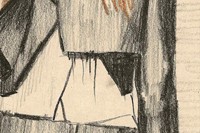Harriet Walker looks into the charm of the raw edge
When you're paying over the odds for a blazer or a pair of trousers, you expect them to be finished properly. But the disintegrating hems of Miuccia Prada's S/S10 collection are indicative of anything but shoddy workmanship.
Martin Margiela has long shown gnarled edges. For his first collection, he famously recalibrated pattern-cutting machines so that the overlock of a seam was not sliced off, but left to trail.
He called it “authenticity,” others dubbed it "damaged beauty" or "la mode destroy" - and attached shoulder pads to the exteriors of jackets, with ripped tights worn over erstwhile outer garments. Sleeves were pulled off blazers and threads dangled in their wake. He ripped holes in dresses and pulled the lining through, inviting the wearer to become part of the internal logistics of their clothing.
In the 1900s, the couture house Worth covered jagged edges with grosgrain and velvet trim. In the 1980s, Ann Demeulemeester left them frayed to create her intellectual goth look. Alber Elbaz's superbly luxe evening gowns at Lanvin are as raw-edged as if you made them yourself in the haberdashery department.
The point, however, is that you didn't make them, and you never could. This hyper-focus on the very dismantling of clothes, and therefore on the concept and construction involved in their creation, is a further trick of the designer's own omnipotence. Prada's fraying workwear is as consciously man-made as the Japanese resort that she used as a print on her sundresses and skirts; constructing in order to deconstruct has always been one of fashion's most powerful economic statements.
Harriet Walker is a fashion writer at The Independent
Zoë Taylor graduated from the Royal College of Art in 2009. Her work has appeared in Le Gun, Bare Bones, Ambit and Dazed & Confused. She is currently working on her third graphic novella and an exhibition



